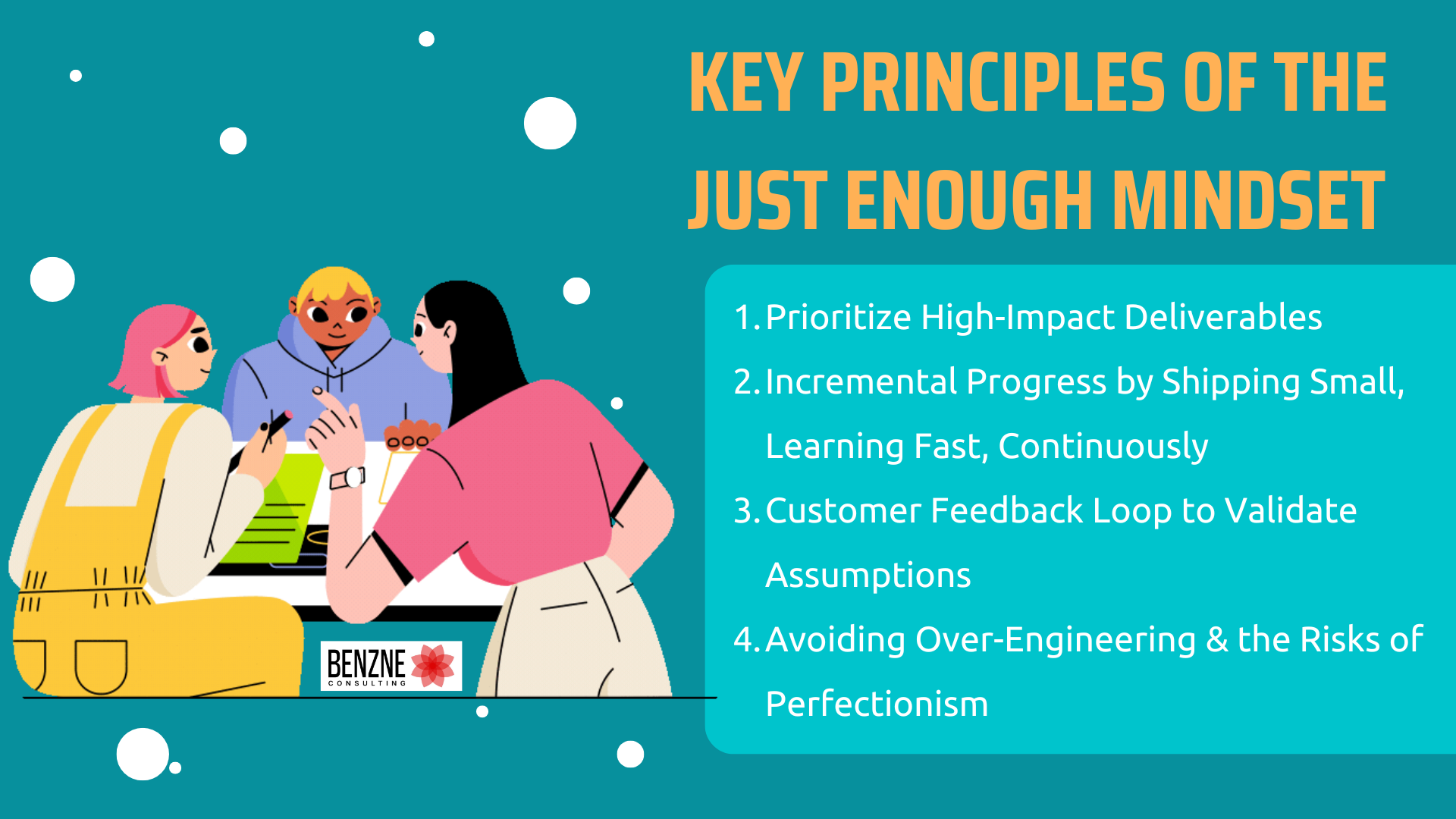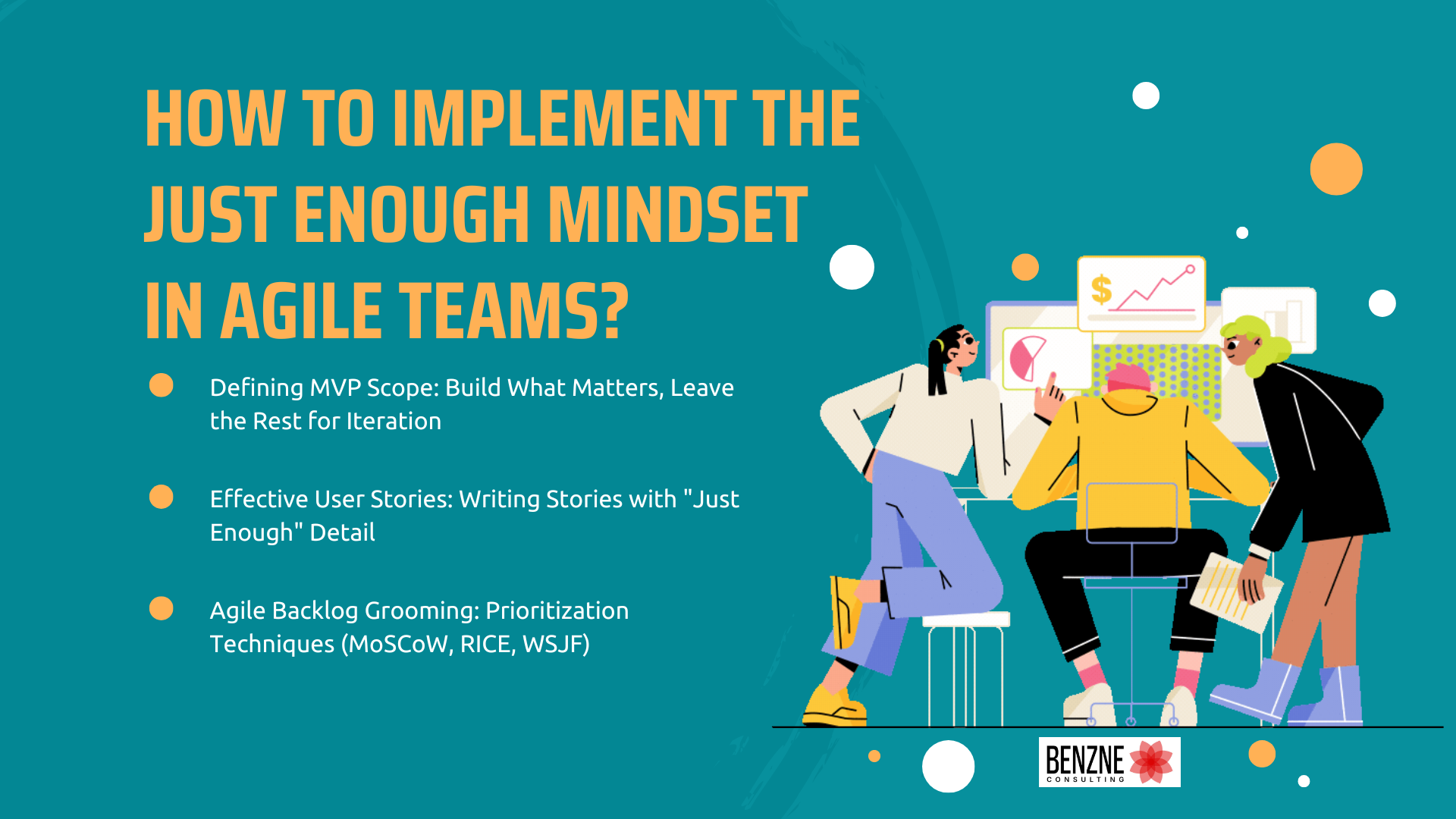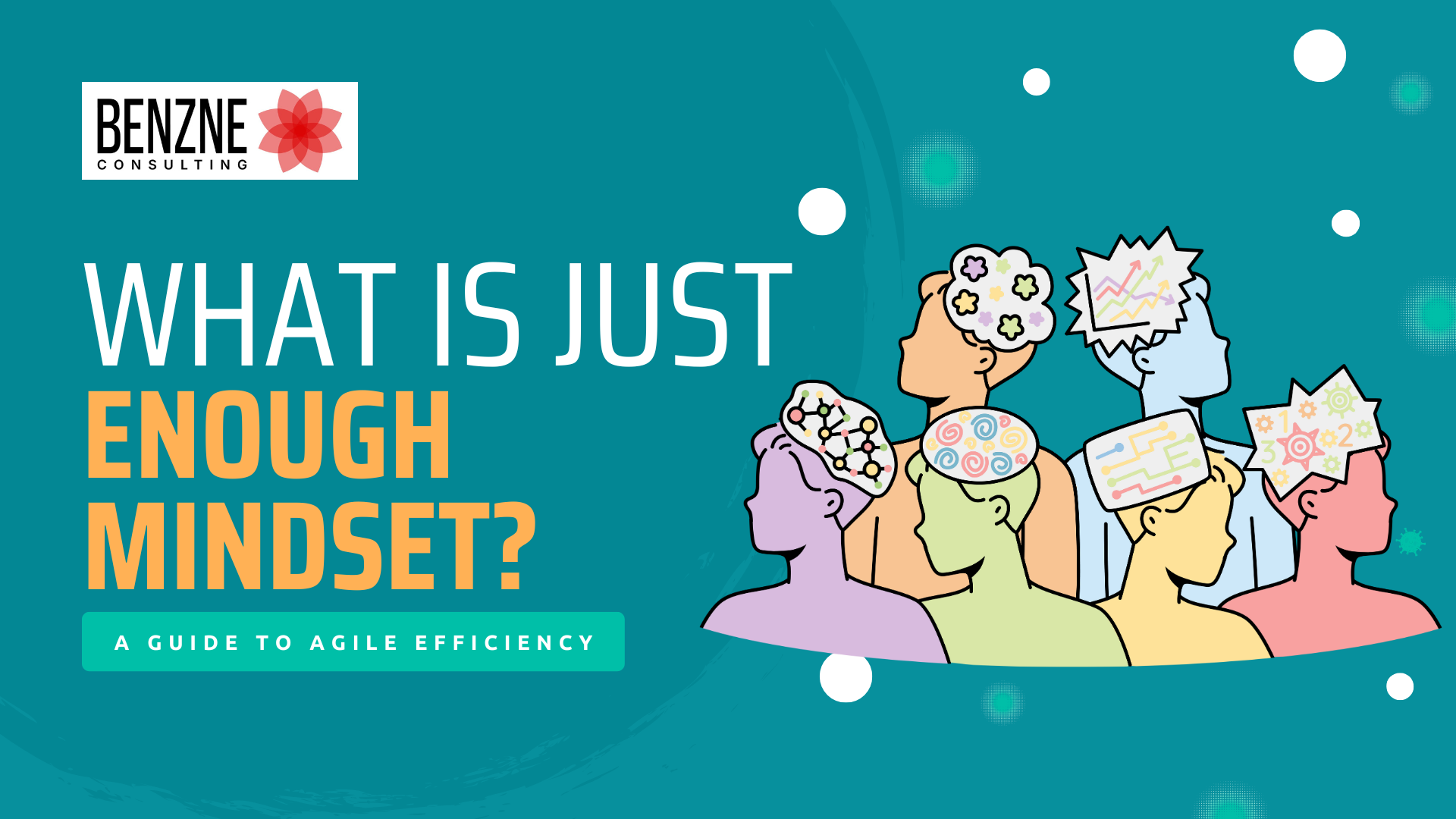Introduction
In a world obsessed with more, bigger and faster, a quiet revolution is brewing – the just enough mindset. It is not about cutting corners; instead, a deliberate and powerful approach to work and life that emphasizes effectiveness over excess, impact over volume, and learning over perfection.
My grandfather used to tell me a story set in our village – Rohan and Vikram aimed to build wells for their parched village in Madhya Pradesh, India. Rohan envisioned a magnificent, perfect well, meticulously planned and slowly crafted with the finest of material by the best of craftsmen. Vikram focused on a simple, functional design and quickly began digging with a small team and locally available resources.
Within weeks, Vikram’s unadorned well yielded precious water, quenching the village’s immediate thirst and earning him their gratitude. Rohan’s grand project, though admired for its future potential, remained unfinished.
Vikram, having met the urgent need, continued to improve his well based on the villagers’ feedback. Rohan eventually completed his masterpiece, but the profound initial impact and the community’s trust belonged to Vikram, who understood that providing “just enough” value swiftly often creates the greatest difference.
Moral of the story: Prioritizing a timely, functional solution (“just enough”) can often generate a more significant and immediate positive impact than pursuing a delayed, perfect outcome.
In the same way, for Agile teams striving for efficiency and value delivery, and for individuals navigating the complexities of modern living, adopting a just enough mindset can be the key to unlocking sustainable success and reducing unnecessary stress.
This blog investigates deep into the philosophy and practical application of the just enough mindset. We will also explore what it truly means, the growing need of just enough mindset in today’s fast-paced environment, its core principles, and how it can be implemented across various domains, particularly within Agile frameworks. Remember, applying just enough principles is about making conscious choices to invest our time and resources where they yield the most significant returns.
What is Just Enough Mindset?
At its core, the just enough mindset is a pragmatic philosophy that advocates for doing precisely what is needed to achieve a desired outcome – no more, no less. Ask yourself a question, Where is the sweet spot between under-delivering and over-investing?.
One way to look at it is to aim for the bare minimum but that is an incomplete approach because that may lead to a compromise. This mindset is absolutely not about that. It is about intelligently assessing the situation, understanding the requirements, and applying the necessary effort and resources to meet those requirements effectively and efficiently.
Think of it like adding salt to a dish. Too little, and the flavors are bland. Too much, and it becomes unpalatable. The skilled chef understands the Just Enough Principle – adding the precise amount needed to enhance the taste without overpowering it.
Just enough mindset is an endeavor that involves finding that optimal balance.
Understanding the Just Enough Mindset
Moving beyond the simple definition, just enough mindset involves a fundamental shift in perspective. It requires:
- A deep understanding of the goal you are trying to achieve. Without this clarity, it’s easy to get lost in unnecessary details and over-complicate things.
- A conscious decision to allocate resources (time, effort, money) deliberately and strategically, focusing on what truly moves the needle.
- A realistic assessment of what is achievable and what is truly necessary in a given context. It involves letting go of the pursuit of unattainable perfection at the outset.
- A willingness to iterate and adjust based on feedback and new information. The “enough” might evolve as the situation unfolds.
- Trust in your & team’s abilities to deliver effectively without excessive oversight or control.
The just enough mindset isn’t a static state; it’s a dynamic process of continuous evaluation and adjustment. It requires critical thinking, effective communication and a willingness to challenge the status quo.
Why the Just Enough Mindset Matters in Today’s World?
In our hyper-connected and information-saturated world, the pressure to do more, be more, and achieve more can be overwhelming. This often leads to:
- Overwhelm and Burnout: Trying to do everything perfectly can lead to exhaustion and decreased productivity.
- Wasted Resources: Over-engineering solutions or pursuing unnecessary features consumes valuable time, money, and effort.
- Delayed Value Delivery: The pursuit of perfection can significantly slow down the time it takes to get a product or service into the hands of users.
- Analysis Paralysis: Spending too much time planning and analyzing can prevent action and adaptation.
Just enough mindset offers a powerful antidote to these modern challenges. By focusing on what truly matters and delivering value incrementally, individuals and organizations can:
- Increase Efficiency: By eliminating unnecessary tasks and focusing on high-impact activities.
- Accelerate Learning: By getting something “good enough” out quickly and gathering real-world feedback.
- Reduce Waste: By avoiding over-engineering and building features that may never be used.
- Improve Adaptability: By being flexible and responsive to change based on early learnings.
- Enhance Well-being: By reducing the pressure of perfectionism and fostering a more sustainable pace.
The Just Enough Principle is not about settling for less; it’s about strategically choosing to invest wisely for maximum impact.
Key Principles of the Just Enough Mindset
The just enough mindset is underpinned by several core principles that guide its application:

1. Prioritize High-Impact Deliverables
At the heart of the just enough mindset lies the ability to effectively prioritize. This involves identifying the most critical tasks or features that will deliver the most significant value. Techniques like the Pareto Principle (80/20 rule) can be invaluable here, helping to identify the 20% of effort that yields 80% of the results. By focusing on these high-impact deliverables, we can achieve significant progress without getting bogged down in less crucial details.
2. Incremental Progress by Shipping Small, Learning Fast, Continuously
Instead of striving for a perfect, fully-fledged solution from the outset, the just enough mindset encourages breaking down work into smaller, manageable increments. This allows for faster delivery, quicker feedback loops, and the ability to adapt based on real-world usage. The mantra here is “ship early and often,” delivering “just enough” functionality to validate assumptions and gather valuable insights.
3. Customer Feedback Loop to Validate Assumptions
A cornerstone of the just enough mindset in product development is the continuous integration of customer feedback. The goal is to build “just enough” of a product or feature to get it in front of users and gather their reactions. This feedback then informs the next iteration, ensuring that development efforts are aligned with actual user needs and preferences. This iterative approach minimizes the risk of building something nobody wants.
4. Avoiding Over-Engineering & the Risks of Perfectionism
Perfectionism can be a significant obstacle to agility and efficiency. The pursuit of a flawless initial product often leads to doing too much, consuming excessive time and resources. In contrast, the just enough mindset in agile recognizes that software development is an inherently iterative process. Building “just enough” functionality that meets the immediate needs and is well-tested is often more valuable than striving for a perfect, gold-plated solution that takes months to deliver. The risks of over-engineering include delayed time-to-market, wasted effort on features that may change, and a decreased ability to respond quickly to evolving requirements.
Just Enough Mindset in Business and Work
I remember when I first started using Waze. It was not the prettiest or the most feature-packed navigation app out there initially. But it nailed the essentials:
- Getting me from A to B with the most up-to-date traffic info.
- Reliance on us, the users, for real-time updates.
It felt lean but incredibly effective. Over time, more features were added, but that core, ‘just enough’ approach of community-driven navigation was always its strength. For me, Waze perfectly illustrates how focusing on core value and evolving based on real-world use can create something truly impactful.
The just enough mindset has profound implications across various aspects of business and work:
Agile & Lean Thinking
The just enough mindset is deeply intertwined with the core principles of Agile and Lean methodologies. Agile emphasizes delivering working software frequently, prioritizing based on value, and responding to change over following a rigid plan. Lean thinking focuses on eliminating waste and maximizing value flow. Both approaches advocate for building “just enough” to learn and adapt, avoiding unnecessary complexity and focusing on delivering value to the customer as efficiently as possible.
SaaS Growth & Scaling
If you are aware of Zoho, instead of launching a massive, integrated suite from the outset, Zoho strategically built individual applications – like Zoho Writer (a basic word processor), Zoho Sheet (a simple spreadsheet), and Zoho CRM – each addressing a specific need with essential functionalities. They focused on making these individual tools user-friendly and affordable.
This allowed them to enter the market quickly with tangible value, attract users with specific pain points, and gather feedback on each application. Over time, they incrementally expanded the features of each product and, crucially, began to integrate them into the comprehensive Zoho One suite we know today.
Productivity Hacks
We want to identify the trap of busy work & focus on the most impactful tasks. And the toughest job is to identify the vital few tasks that will yield the most significant results and dedicate energy to those, rather than trying to tackle everything on the to-do list with equal intensity. This involves effective prioritization, time blocking for focused work, and learning to say “no” to less important commitments. Let’s learn more about it in the next heading.
Just Enough Mindset in Personal Life
Think about cleaning your house. You could spend hours making every corner spotless. Or, you could clean the main areas and leave the less-used spots for later. That’s “just enough.” You still have a clean enough house to be comfortable, but you haven’t wasted your whole day cleaning.
With money, it means making smart choices and saving steadily, not chasing every risky investment. For your health, it’s about eating reasonably well and moving your body regularly, not trying to become a super athlete overnight.
The “just enough” way helps you have more time and less stress. It’s about focusing on what truly makes your life better, without getting caught up in trying to be perfect at everything. It’s like watering the plants that are important for your garden to grow, instead of fussing over every single leaf. The benefits of the just enough mindset extend far beyond the professional sphere, positively impacting various aspects of personal life:
Time Management
Applying the just enough mindset to time management involves identifying the activities that truly bring joy, fulfillment, or progress towards personal goals and focusing on those. It’s about recognizing when “good enough” is truly sufficient for less critical tasks, freeing up time and energy for what truly matters. This could mean a less-than-perfectly clean house or a simpler meal, allowing more time for hobbies or spending time with loved ones.
Financial Decisions
In financial planning, the just enough mindset encourages making sound and practical decisions without getting caught up in excessive speculation or the pursuit of unrealistic returns. It’s about understanding your financial goals, creating a sensible budget, and investing wisely based on your risk tolerance and time horizon, without constantly chasing the next “get rich quick” scheme.
Health & Well-being
The pressure to achieve peak physical fitness or adhere to overly restrictive diets can be detrimental to long-term well-being in the sense it is prone to failure. The just enough mindset in this context advocates for sustainable and balanced approaches to health. This might mean aiming for “good enough” nutrition and regular exercise that fits into your lifestyle, rather than striving for an unattainable ideal that leads to burnout or discouragement.
How to Implement the Just Enough Mindset in Agile Teams?
Implementing the just enough mindset in agile requires a conscious effort and a shift in team culture. Here are some practical strategies:

Defining MVP Scope: Build What Matters, Leave the Rest for Iteration
The concept of the Minimum Viable Product (MVP) is to identify the smallest set of features that delivers value to users and allows for validation of assumptions. The focus is on building “just enough” to learn and iterate, rather than trying to build a perfect, fully-featured product from the outset.
Effective User Stories: Writing Stories with “Just Enough” Detail
When writing user stories, the just enough mindset encourages providing sufficient information for the team to understand the requirement and begin work, without getting bogged down in excessive detail that may change. The focus is on clarity and enabling conversation, rather than creating exhaustive documentation upfront. The INVEST principles (Independent, Negotiable, Valuable, Estimable, Small, Testable) align well with this approach.
Agile Backlog Grooming: Prioritization Techniques (MoSCoW, RICE, WSJF)
Effective backlog grooming is crucial for maintaining a just enough backlog. Prioritization techniques like MoSCoW (Must have, Should have, Could have, Won’t have), RICE (Reach, Impact, Confidence, Effort), and WSJF (Weighted Shortest Job First) 1 help the Product Owner and the team focus on the most valuable items and avoid overloading the backlog with low-priority or unnecessary features. These techniques facilitate Just Enough Thinking about what truly deserves the team’s attention.
Balancing Speed and Quality: When is “just enough” not enough?
While we pursue efficiency, it’s crucial that we should never compromise essential quality standards, security, or compliance requirements. There are situations where a more thorough approach is necessary to mitigate risks or ensure long-term maintainability. The key is to make informed decisions based on the specific context and potential consequences of cutting corners. The Just Enough Principle should be applied judiciously, considering the trade-offs between speed and quality. I believe quality is sacrosanct and should not be compromised.
Just Enough vs Doing Too Much in Agile
The contrast between the just enough mindset in agile and the tendency to do too much is stark. Doing too much often manifests as:
- Adding unnecessary enhancements (gold-plating)
- Creating excessive documentation that is rarely used or quickly becomes outdated.
- Analysis paralysis
- Developing functionalities without validating them with users.
The just enough mindset, on the other hand, promotes:
- Delivering the most impactful features first.
- Lean documentation
- Embracing iteration and learning through doing.
- Data-driven decisions
Conclusion
The just enough mindset is more than just a productivity hack; it’s a fundamental shift in how we approach work and life. It’s about embracing pragmatism, prioritizing effectively, and focusing on delivering value incrementally. In the context of Agile, the just enough mindset in agile is a cornerstone of efficient and effective product development, enabling teams to build what matters, learn quickly, and adapt to change with agility. By consciously applying the Just Enough Principle, we can move away from the trap of overdoing and towards a more sustainable and impactful way of working and living. Embracing the power of “just enough” allows us to thrive in today’s complex world, achieving more by focusing on what truly matters.
With this, our blog on “What Is Just Enough Mindset? A Guide to Agile Efficiency” comes to an end. We sincerely hope this has helped our readers get some clarity around it. We would be glad to discuss your unique agility adoption bottlenecks at Benzne Agile Transformation consulting and support your agile journey. Please write to us at “consult@benzne.com” for any further feedback or recommendations or in case you are looking for external coaching support.
Frequently Asked Questions on Just Enough Mindset:
1. Is the Just Enough Mindset applicable beyond Agile?
Absolutely. It is a versatile principle that can be applied to various aspects of life, including personal productivity, time management, financial decisions, health and well-being, and even creative endeavors. The core idea of focusing on effectiveness and avoiding unnecessary excess is universally beneficial.
2. Can the Just Enough Mindset lead to technical debt?
If applied incorrectly, focusing solely on “just enough” in the short term without considering long-term maintainability and scalability can potentially lead to technical debt. However, a mature application of the just enough mindset involves making conscious trade-offs and ensuring that “enough” includes a reasonable level of quality and architectural considerations to avoid accumulating excessive technical debt.
3. Can the Just Enough Mindset work in highly regulated industries?
Yes, the just enough mindset can be applied in highly regulated industries, but with careful consideration. While rapid iteration and early releases are still valuable, “just enough” must always encompass full compliance with all relevant regulations and quality standards. The focus is on finding the most efficient way to meet those stringent requirements, avoiding unnecessary bureaucracy and documentation while ensuring thoroughness.
4. What are the risks of applying Just Enough incorrectly?
Applying the just enough mindset incorrectly can lead to under-delivering, compromising quality, or neglecting crucial aspects of a product or task. It’s essential to have a clear understanding of the requirements and potential consequences before deciding what constitutes “enough.” The key is to strike a balance between efficiency and effectiveness, ensuring that “just enough” truly meets the necessary standards and delivers the intended value. Seek external help from external experts from reputed agile consulting firms if you are in doubt.

